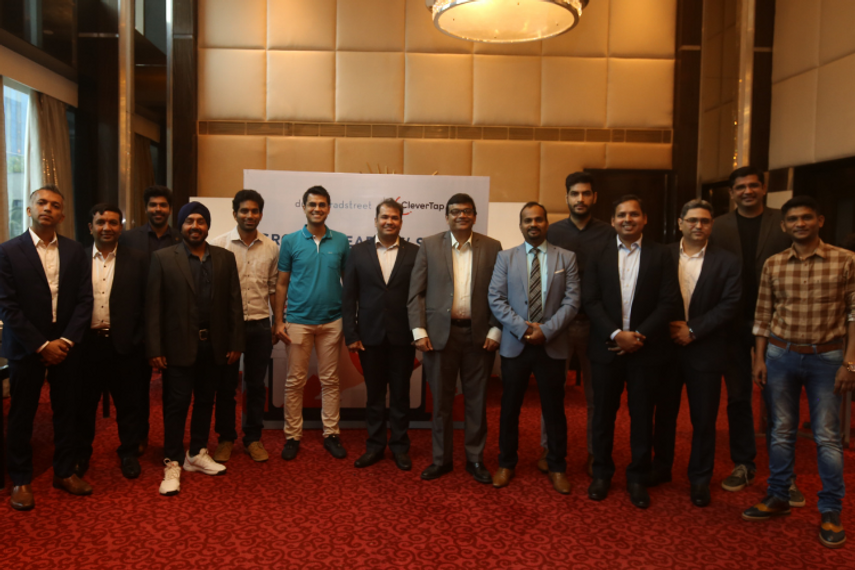
Dun & Bradstreet India, along with CleverTap, hosted a roundtable discussion on 30 November in Mumbai which discussed ‘retention as a growth lever’.
It focused on strengthening innovation in the pursuit of retaining customers, thereby leading to profitability.
The panel comprised Deepak Kadam, head of e-commerce, Baby Chakra; Jasmeet Singh Gandhi, head global BD, CleverTap; Prasanna Lohar, head technology – digital, innovation, architecture, DCB Bank; Praveen Chaudhary, Apac lead - growth and retention, Discovery Plus; Gaurav Verma, director - user growth, Games24x7; Rumit Anand, group product manager, Glance; Dinesh Dua, head of service - merchant services, payment, e-commerce, HDFC Bank; Ravi Raj Dhiria, head – marketing programs, HDFC Securities; N K Purohit, chief digital officer, IIFL Securities; Niyaz Ahmed K, chief product officer, MyGlamm; and Dinesh Vernekar, head of app product, OneCard and OneScore. The session was moderated by Vipul Oberoi, director - marketing, Dun & Bradstreet India.
Acquisition vs Retention
Starting the discussion in the momentum of consumer retention, Vernekar remarked, “We always look at the retention curve. This curve needs to flatten. If it does not flatten, we will always face the pressure of acquiring more customers."
Acquisition at a fast pace creates imperfections in the journey to retention. Shedding more light on this, Chaudhary said, "When acquisition takes place at a fast pace, the flaws on the retention side get masked. We need to be careful and distinguish by figuring out what is lacking on our platform despite the acquisition numbers.”
Furthermore, regulations have been a slight challenge to help scale the retention funnel further Chaudhary pointed out.
For Verma, the retention metric is optimising their campaigns and chasing the threshold of their players wins. He said, “When the consumer is engaged in the platform it is easier to make money later. But if he is not engaged in the initial weeks, he won’t return. The north star metric for us is also the players win as he builds up an adrenaline rush and would want to play more."
Gandhi shared that the retention and engagement strategy are based on respective categories. He said that what they are fighting for is a share of time.
Talking about how frequency impacts his engagement strategy and retention metrics, Purohit said, "With digital engagement, acquisition and communication start to build cohesion. That is where the problem arises when there is a certain cost of acquisition and metrics for acquisition. We are now trying to achieve what the customer is looking for while initiating a relationship with us. Looking at the data the retention problem can be solved as we will understand the intent.”
Purohit emphasised a singular lense for acquisition and retention instead of two separate funnels. He believed that the digital ecosystem can provide platforms by creating a singular metric that will result in customer lifetime value.
Anand said, “We need to define the use case. It can be done in the form of a hypothesis or data. Acquisition and retention is the outcome of the inputs we give in. If the core value proposition for the customer is not clearly defined it is difficult to drive revenue. Retention is metric and it is the crux of any organisation. We need to focus on measurement of data, defining the frequency and lastly, the objective is to define the entire product strategy based on the results. For any platform to be successful we need to figure out the core value proposition.”
According to Ahmed K, providing offers and spamming consumers are not going to drive sales. He said, “We need to give consumers value. For us, we send content and makeup videos to consumers who purchase a new lipstick. They engage with the brand and then we segment them and give offers accordingly.”
Dhiria pointed out that a ring fencing approach and providing consumers with instant gratification offers after the acquisition process is essential.
Enhancing user experience
Talking about churning revenues while scaling up a consumer's user journey, Anand shared, “From a data perspective, users can fundamentally fit into buckets and activated cohorts, this is essential for consumers using the product for its core value. If the activation and engagement rates are going down it is the biggest indicator that needs attention. We need to create relevance and develop meaningful interactions.”
Kadam stated that when it comes to e-commerce, giving an experience to an acquired user is important. He said, “In e-commerce, the products should solve the consumer’s purpose and the online purchase experience should be seamless. We need to understand where the dropouts from the app are occurring from the consumer end. Our strategy has an approach of 'by the community for the community'. We take cohorts and formulate them to give a targeted notification so that the consumer feels privileged to be part of the app. The right context is imperative.”
Challenges on the road to retention
Oberoi then asked the panellists about the challenges regarding retention.
Ahmed K said, “Identifying new features, and user’s CTR, is an ongoing challenge.”
For Vernekar the challenge was talent in product building. He continued, "We are still at a nascent stage in the startup world. Understanding how we need to measure consumer data and build a product is a challenge that requires a lot of time. An extra effort needs to be taken, especially when the service of the product is dipping by checking the pain points in the system."
Chaudhary stated that the challenge for them is the payment ecosystem in India in terms of retention. “Most of the users have used auto payments that do not support auto-renewal", he said.
Lohar and Anand echoed the same challenge of understanding the consumer.
Verma added that the challenge for them is engaging with the consumer when there are no fantasy gaming events to play.
Purohit pointed towards data and science. “The crux is when you acquire a consumer there is a sea of information provided and the retention problem can be solved with this data", he said.
For Gandhi, it is personalising at scale to provide tools like segmentation and develop cohort analysis to help discover the use case of a relevant customer.
Final thoughts
Giving the closing remarks on the topic, Gandhi said, “Retention has become core to the entire digital ecosystem or any legacy business that is transforming into a digital space. The cost of acquisition today is high, plus how do we retain or increase the frequency of the usage of digital assets is becoming the cornerstone of an increase in lifetime value.”


.jpg&h=334&w=500&q=100&v=20250320&c=1)
.jpg&h=334&w=500&q=100&v=20250320&c=1)



.jpg&h=334&w=500&q=100&v=20250320&c=1)
.jpg&h=334&w=500&q=100&v=20250320&c=1)


.jpg&h=334&w=500&q=100&v=20250320&c=1)
.png&h=268&w=401&q=100&v=20250320&c=1)

.png&h=268&w=401&q=100&v=20250320&c=1)
.png&h=268&w=401&q=100&v=20250320&c=1)
.jpg&h=268&w=401&q=100&v=20250320&c=1)

.jpg&h=268&w=401&q=100&v=20250320&c=1)

